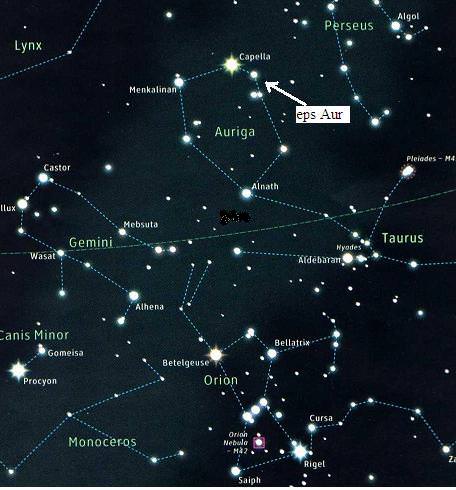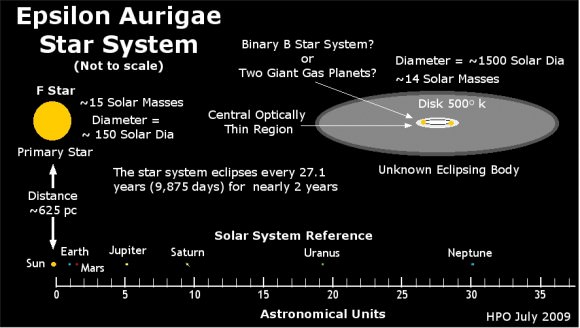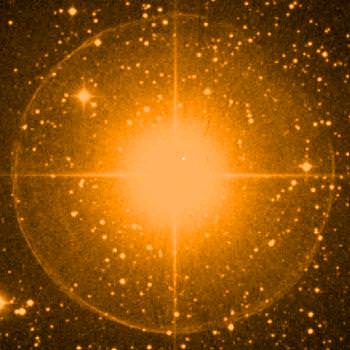[/caption]
We’ve written about Epsilon Aurigae before, but this mysterious star is just now beginning to dim, so we wanted to remind everyone that they can be involved in real science and help solve a mystery! The variable star Epsilon Aurigae is now beginning its puzzling transformation that happens every 27 years. “That means the last time Epsilon Aurigae had an eclipse we were all rockin’ big hair and sporting shoulder pads in all of our clothes,” said Rebecca Turner, coordinator for a special project for the IYA organized by the American Association of Variable Star Observers (AAVSO). Astronomers can’t figure out why this mysterious star dims on a regular basis, so to help solve the mystery they are calling for assistance from thousands of citizen scientists.
That means you can help contribute to real astronomical research!
Since its discovery in 1821, the supergiant star Epsilon Aurigae has dipped in brightness like clockwork every 27.1 years as it is eclipsed by a very large companion object. But based on the shape of the lightcurve and the spectra that have taken of the system, astronomers can’t figure out what exactly what kind of object is eclipsing the star. Another strange feature of the lightcurve is that there is a slight brightening in the middle of the eclipse.
“The leading theory is that the secondary is surrounded by a large opaque disk,” said Turner, on the July 7 episode of the 365 Days of Astronomy podcast. “This would explain why light from the secondary doesn’t seem to be showing up in spectra. The disk seems to have a hole in the center, which would account for the mid-eclipse brightening. Current thinking is that perhaps the center of the disk is home to 2 less luminous, tightly orbiting stars. This tight orbit could create what astronomers are calling a gravitational eggbeater effect – creating that hole in the disk. Theories of a large planet falling into the stars at the center of the disk have also been introduced recently.”

Epsilon Aurigae is a bright star that can be seen with the unaided eye even in bright urban areas of the Northern Hemisphere from fall to spring. But it is also too bright for most professional telescopes to observe, so this is where the public comes in.
“It’s not just amateurs with fancy telescopes and CCDs or photoelectric photometers that are needed for this experiment,” said AAVSO’s Mike Simonsen. “People with just their eyes or a pair of binoculars can contribute to understanding this weird star by observing epsilon Aurigae over the next two years and reporting their observations to AAVSO.”

For this project, a new website has been launched called “Citizen Sky”, and all you need are a good pair of eyes, and a finder chart, which can be found on the website. No previous astronomical experience is necessary.
The project is supported by a three-year grant from the National Science Foundation to recruit, train, and coordinate public participation in this project. What makes this project different from previous citizen science projects is its emphasis on participation in the full scientific method. Participants are not being asked simply to collect data. They will also be trained to analyze data, create and test their own hypotheses, and to write papers for publication in professional astronomy journals. Participants can work alone on all phases of the project or they can focus on one stage and team up with others.
Epsilon Aurigae is just now beginning to dim. It will remain faint during all of 2010 before slowly regaining its normal brightness by the summer of 2011.
The lead astronomer for this project is Dr. Robert Stencel, the William Herschel Womble Professor of Astronomy at Denver University. Dr. Bob, as the amateur astronomy community knows him, studied the last event in 1982-84 while working at NASA. “This is truly an amazing star system. It contains both a supergiant star and a mysterious companion. If the supergiant was in our solar system, its diameter would extend to Earth, engulfing us,” Stencel said. “The companion only makes its presence known every 27 years and is a type of ‘dark matter’ in that we indirectly detect its presence but don’t know what it is.
“To make things even more fun, we also have some evidence of a substantial mass, perhaps a large planet, spiraling into the mysterious dark companion object. Observations during the upcoming eclipse will be key to understanding this and predicting what will happen if the putative planet does eventually fall into the star,” Dr. Bob added.
Here’s a video with Rebecca Turner explaining more about Citizen Sky.
For more on Epsilon Aurigae, see this page from AAVSO
Citizen Sky
Sources: 365 Days of Astronomy,


Obviously we found the ringworld.
I wish that you Americans would use the term autumn, instead of “fall”, when referring to the season.
IVAN: In Americanese the two terms are interchangeable. I have no idea why, but they are.
I might suggest a model for this. As a model it is of course subject to testing or falsifiability.
As for ringworlds, last winter I read a paper which suggested an ETI might place geommetric shapes or masking strips in orbit around their star to communicate a message. For various reasons I think these ideas are unlikely, even if entertaining.
LC
IVAN3MAN. The term ‘fall’ is actually an old English expression that was used very widely up until late Victorian times here in Britain.
Paul.
I’m thinking it’s a brown dwarf, possibly with an orbiting planet.
DrFlimmer, you can see an artistic rendering of the Epsilon Aurigae star system here.
Paul Eaton-Jones,
According to Wikipedia, autumn traces its origins to old Germanic languages. The term came to denote the season in the 16th century, a contraction of Middle English expressions like “fall of the leaf” and “fall of the year”.
When English immigration to the North American colonies was at its peak during the 17th century, the new settlers took their language with them. While the term “fall” gradually became obsolescent in Britain, it became the more common term in North America, where “autumn” is nonetheless preferred in scientific and often in literary contexts.
So, the English language is evolving here in Britain, but in America it’s still stuck in the Dark Ages — like the belief in creationism!
My idea is that the secondary object is a black hole that is orbiting the star in a way that it revolves in the line-of-sight. This could also explain the brigthening in the middle of the dimming: a gravitational lense; the light of the star is focused to us for the short moment that eart, BH and the star are actually in one line.
But I guess that I’m not the first one with such an idea and that is has already been tested and dismissed. Too bad! 😉
ERRATUM: At my post above, the link word should be fall, not “autumn” — which comes from the Old French word autompne, later normalized to the original Latin word autumnus.
Thanks, Ivan3man.
Apart from the fuzzy edges, it looks like the Alien-spaceships from “Independence Day”…. 😉
The informative Wiki page on Epsilon Aurigae can be found here: http://en.wikipedia.org/wiki/Epsilon_Aurigae . Thanks, IVAN3MAN. for the beautiful artwork that you linked to earlier wrt Epsilon Aurigae. This system fascinated me as far back as when I attended high school in the mid-70s.
@ Jon Hanford,
The Epsilon Aurigae system has fascinated as well, and it’s a cool name too!
Grrr… Take two:
Jon Hanford, the Epsilon Aurigae system has fascinated me as well, and it’s a cool name too!